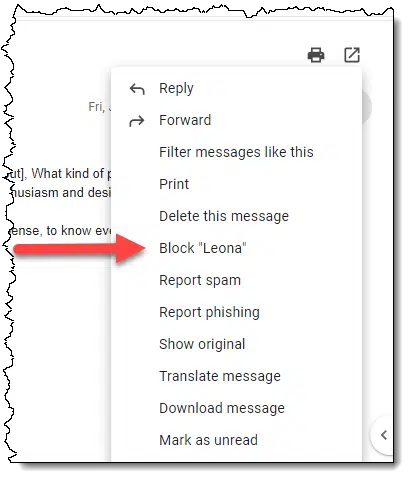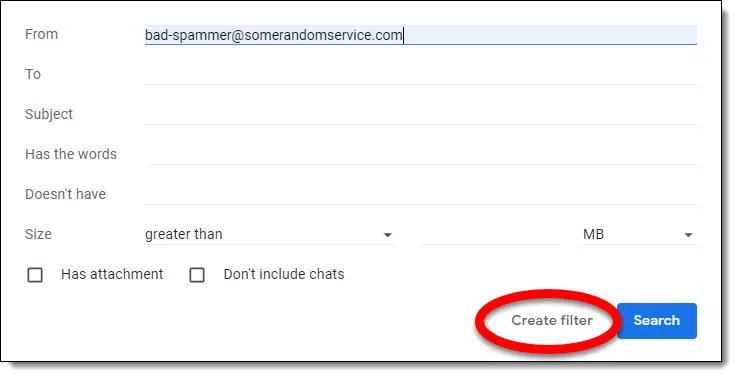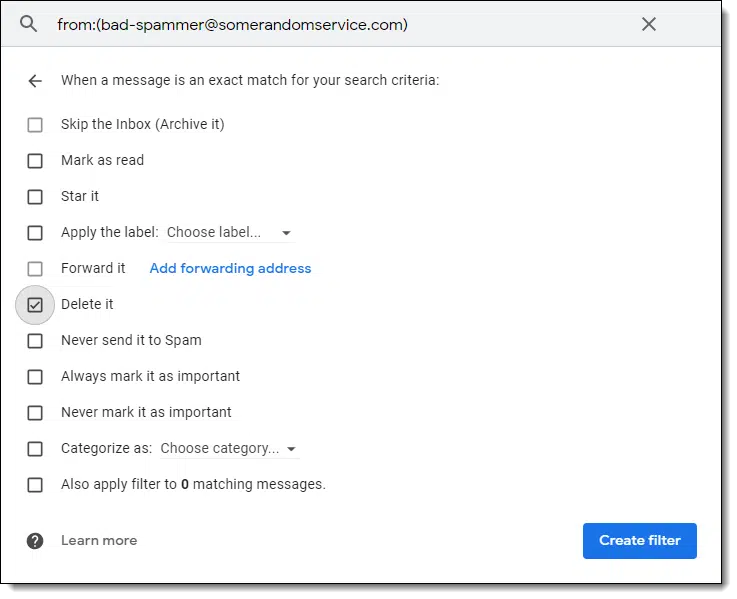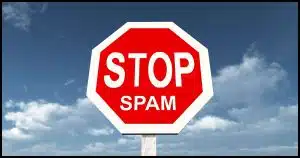Time to take a different approach.

It’s unfortunate, but there are definitely some overly aggressive, to put it mildly, companies out there.
I’m not really talking about spam. We all get that, and of course, you should never try to unsubscribe from spam.
This is about legitimate companies who abuse the privilege of sending you email and won’t stop when you ask politely.
It’s time to get less polite.
Become a Patron of Ask Leo! and go ad-free!

When unsubscribe doesn't work
Make sure the email was sent after you unsubscribed. Depending on your email program or interface, your options to prevent messages from an unwanted sender include marking them as spam repeatedly, using an explicit “block sender” feature, or creating a filter or a rule to automatically delete their messages. If none of those options work for you, deleting each message as it arrives is a quick and reliable solution.
Check the date
Before you get upset, check the date of the email you think you received after you unsubscribed.
If it was sent before you unsubscribed, the sender’s done nothing wrong — not yet, anyway. They sent that message to you before you asked them to stop.
It’s not uncommon to work through a long list of email in most-recent-first order, unsubscribe from a mailing, and encounter older messages as you work your way through your email. I’ve heard of people getting upset because they think the messages had been sent after unsubscribing. Check the date.
When you unsubscribe, give them at least a day to take action.
But don’t expect them to travel back in time. That technology doesn’t exist yet, at least not that I’m aware of.
Mark it as spam
This is my go-to response. If someone is sending you email, and you follow the proper procedure to ask them to stop (meaning you unsubscribed), continuing to send you messages makes them a spammer. It’s the very definition of spam: unsolicited commercial email. Once you’ve said stop, it’s unsolicited in my book.
In theory, if you mark something as spam often enough, the spam filter should get the message and begin routing those messages to your spam or junk folder automatically.
The problem, of course, is that marking as spam doesn’t always work, and it doesn’t always work quickly. It depends on the email system and spam filter you’re using. Some systems seem to get your intent quickly while others seem to completely ignore the suggestion.1
Some systems act on your personal opinion and realize that you think it’s spam. Others use the so-called “wisdom of the crowd” and won’t start marking it as spam until a number of other people have marked it as spam as well.
So if marking it as spam works, great. It’s my preferred solution.
If it doesn’t, we need alternatives.
Block senders
This isn’t available in all mail programs and isn’t something I recommend for run-of-the-mill spam. However, if you’re getting spam from a consistent source — the same “From:” address on each message — blocking them is an option.
For example, when you’re viewing an email in Gmail, click the vertical ellipsis, and one of the options will be to block the sender.

Now when you look at Gmail settings, in “Filters and Blocked Addresses” you’ll see a list of the email addresses you’ve blocked.

Many online email services and some email programs have a blocking feature. It’s usually in their Junk Mail or Spam settings.
Remember: this only blocks a single email address. Spammers routinely change the “from” on their messages, which is why blocking normal spam doesn’t work. But if you’re getting unwanted messages from the same email address over and over, “block sender” is an option.
One rule to spam them
If blocking isn’t an option, or you want finer control over what happens, set up a rule or filter in your email program or interface to automatically act on the message when it arrives.
For example, in Gmail’s Filters and Blocked Addresses settings, you can Create a new filter and specify the email address you want it to operate on.

After specifying the search criteria — in this case, the email address we wish to block — we can specify what happens.

Oddly enough, “Mark as spam” isn’t an option in Gmail filters, so the next best thing is to automatically delete it. Many other programs and interfaces also let you mark it as spam in their filters.
I mention filters and rules because as you can see, you have much finer control over what gets filtered (perhaps you need to see some of the emails from that address but not others), and what happens (perhaps bypassing your inbox is enough). If blocking the sender doesn’t do it for you, perhaps a more flexible filter will.
Ignore them
I’m amazed at how much ire spam raises. If you’re facing an uncontrolled flood of spam every day, that’s one thing. Hopefully, a good spam folder reduces it to a trickle. (Remember, spam appearing in your spam folder is the system working as it should.)
But even with just a trickle — say a single spam message every day showing up in an inbox — people can get really upset. It seems like life is too short to let the spammers get to you that quickly, but that’s just me.
Unfortunately, if none of the techniques above work or if they aren’t available to you, your options are few. Of course, you can get a new email address, but that’s a tremendous amount of work and complication just to stop one problematic subscription.
My more pragmatic alternative is simply this: the delete key. It’s fast, it’s effective, and it’s always there for you.
Do this
You deserve control.
The bottom line is that whoever is sending you email and offering to unsubscribe you isn’t playing by the rules when they ignore your request. If that’s an issue for you, take matters into your own hands and explore options like blocking, filters, or other techniques to get their messages out of sight.
Podcast audio
Footnotes & References
1: STILL looking at you, Outlook.com.





Hi Leo – thanks as always for a helpful article. I don’t know if you’re familiar with the Mailwasher programme from Firetrust, but I’ve been using it for years and it really helps to identify (and then delete and/or bounce!) unwanted emails before they even hit your machine. The idea being, of course, that if it bounces, then the spam generator will think your email address is not used, and stop sending.
Even if this doesn’t work, Mailwasher will flag all suspect emails (or those you’ve blacklisted) and it’s easy to quickly run down the list and make sure that the treatment of each mail is what you want. It even allows you to restore an email which has been deleted &/or bounced in the last few weeks, if you inadvertently delete one you really wanted. I routinely check mail for all 3 of my accounts through Mailwasher first, before doing send & receive.
It’s funny. Today I marked two emails from legitimate companies. One didn’t include an unsubscribe. It was a textbook company and they were ads I never signed up for. Somehow book companies think they have a God-given right to send spam to people with academic addresses. The other had an unsubscribe but I would have to have filled out a few fields to unsubscribe. Spamming them was easier. If unsubscribe requires any more than a confirmation mouse-click, they deserve to have their emails labeled as spam.
Gmail seems to do a good job of learning to recognize spam after I’ve marked them. Footnote 1 is one of the reasons I don’t use my hotmail address for serious email.
Similar to what you said about books, I get SPAM E-mails all the time about becoming a guest editor for an issue of a journal. All because I published a peer reviewed paper years ago with my personal E-mail address (since I had left my employer). And looking at what you get for being a guest editor, it ain’t much!
Thank you it’s awesome to learn that GMail now has a “block sender” option … that has worked wonders for me in other email programs where the sender did not honor the “unsubscribe”. Blocking seems to trigger some kind of rejection notice that’s more effective than the “unsubscribe” is. I also use the “filter” option, for senders that I want to receive certain kinds of communications from but not emails on other subjects. You can specify a subject or words and send those from that sender directly to the trash without being bothered by them. 🙂
Spam… a perennial problem since it was invented. I’ve rarely had this problem, and when I have, the spam button (in Gmail) has worked fine.
But i wonder if this could cause problems if a company with which I have done business starts sending promotional material with no way to block it. If I use one of these sledgehammer approaches, it would also block account-related messages. Is there any advice on how to contact a company to advise them of the problem and possibly get it fixed?
My attitude is that any company that sends unwanted emails deserves the consequences of being marked as spam no matter how legitimate the company is. Unsolicited email is the definition of spam.
This is probably a stupid question but anyway…
You mentioned unsubscribe as a first choice. I am not arguing with that. I don’t want to unsubscribe. I get a lot out of your articles.
Somewhere or someone once told me to forward their articles to a friend but to delete the “unsubscribe” link so they wouldn’t inadvertently unsubscribe you.
How do you that? What is the proper procedure to break an “unsubscribe” link or any link for that matter? It’s easier said than done for me.
When you forward an email it doesn’t directly sent the email. It first creates an email with the contents of the original email which you can edit out any thing you don’t want. You can even add an introductory paragraph or three explaining why you are forwarding it etc.
How do I remove the sender’s address before forwarding an email? (You can remove more than the sender’s address”
I get so much “SPAM” through Linkeded. Especially recruiters, but I am NOT looking for a job. When I tell them that, then they try to offer to hire staff for me, which I am also not looking. This one lady, I told her several times I’m not interested. She said “gotcha” each time. Finally I unfriended her. She friends me again asking for 5 minute to talk about her company can help hire for me. I have reported to Linkedin as SPAM and blocked her now, but it is frustrating.
I was getting frequent emails from a large, reputable company with whom i had done business twice. On both occassions they had let me down badly. I tried unsubscribing several times with no luck, until I finally decided to write to their head office. I threatened to report them to both their ISP and to Watchdog (a consumer TV show here in the UK) if they didn’t remove me from their mailing list by the end of the next business day. It worked…
From way back, I found that clicking the “Unsubscribe” link usually works to the site I do not want, BUT, within a few days, I start getting a ba-zillon spam mails from everywhere else, even if I have never been to the sites….
Blocking or marking as spam works for a while, then it starts again, with different sites. I usually advise clients do not use unsubscribe link, as I would see the same issue over and over…
Seems once unsubscribed to a site, your good address is sent to the “National Database of Spam”. (NDS)
Just my feelings on the spam industry…….
If unsubscribing gets you more spam, it means you are unsubscribing from a spam email or the increase in spam was just a coincidence. Unsubscribing from a legitimate company won’t get you spam.
One extreme way to get a ‘legitimate’ company’s attention is to post on Twitter including their handle and simply ask: “Why won’t [@company] honor my request to stop sending me unwanted email.” This has worked several times for me.
I’ve used Yelp and Google Reviews to expose spammers. The definition of spam is unsolicited email. “Legitimate” companies don’t get a free pass.
Years ago, when I started using Thunderbird for my email, I set up a filter to mark all emails as spam, if the sender is not in my address book. It works really nicely to keep by inbox clean with only emails I’m interested in.
I’ve found that with most email providers and email programs, when you mark an email as spam, the spam filter blocks the sender and all the email from them will go to the spam folder. That may be why Gmail doesn’t give you the option to send it to spam. Also, when I want to block a specific sender, I’m just as happy to have it go directly to Trash. That way, I don’t have to review it in my spam folder for false positives.
I was really annoyed to find this statement in the Doordash privacy policy as I was about to sign up today, and am very surprised they can presumably get away with this: “Please note that even if you opt-out, you may still receive advertisements from us.” What the heck?!!? Grubhub has no such statement, so I am signing up with them instead.
I mark any advertising email I didn’t specifically ask for as spam.
Spam: “irrelevant or unsolicited messages sent over the internet, typically to a large number of users, for the purposes of advertising, phishing, spreading malware, etc.”
As an exception, I don’t mark as spam email from companies which I might have to do business with later, so I can receive order related emails.
The problem with simply “deleting” unwanted email is one of the biggest reasons I unsubscribe from a list is “sending too many emails.” I had one sender (with something like a dozen different lists) that I “unsubscribed all” six times in as many months; I finally sent a nastygram to a different department and told them nothing was happening there when they tried to redirect me to the “account preferences” page. Now I’ve got another account that hasn’t sent me anything worthwhile in nearly a year, and they’ve ignored three unsubs so far, even though I’ve given them the week they asked for to update their lists.
Don’t unsubscribe from spam. Those unsubscribe links are there to let them know your email address is valid and can be sold to other spammers. It’s fine to use unsubscribe links from legitimate companies.
I get over 50 ‘newsletter@…’ in my Outloook and each time I subscribe, I get a different domain name. I’ve tried creating rules but that doesn’t work. unsubscribing to to each doesn’t work. Does anyone know how to stop getting these endless ‘newsletter@…’ in my junk folder?
If they’re in your junk folder, that’s the system working as it should. Nothing more to do.
(And DON’T UNSUBSCRIBE from things you didn’t sign up for — that just gets you more spam.)
In the article, Leo mentions giving the sender of ‘unwanted’ emails time to remove you from their system. Yes, typically a day or two should suffice. However, some companies use a service like Constant Contact and pre-load several emails at once to be distributed over an extended period of time. The downside is once loaded (as far as I know), the sender cannot delete you from the queue. They can omit you from the next batch of marketing emails, but those pre-loaded will go out. So, you may just have to ride out the short burst before the email barrage stops for good.
I mark them as spam anyway. They should do it better. I mark anything s spam that comes after I’ve hit unsubscribe. I never signed up in the first place so there’s nothing wrong with marking them as spam. The don’t fit the legal definition of spam, but they definitely fit the dictionary definition.”
Cambridge Learner’s Dictionary
“emails that you do not want, usually advertisements”
If I buy something and get a promotional email from that company, it’s spam to me.
It depends on the technology. MOST will in fact remove you from further sending even if preloaded.
The ones that annoy me are those that say it may take up to a week. No. I know how this works. There’s really no reason it shouldn’t be instant (except for email actually sent before I clicked “unsubscribe”, of course).
That’s why I mark any mail that arrives after I’ve unsubscribed as spam. I do this on the email web site so it registers against the company that sent the spam. The only exceprion are emails that conform that I’ve been unsubscribed.
I can usually get rid of soam like Mark Jacobs does bu marking anything that is spam that I dis not request dven from a legitimate company. my main problem is spam from texts. i bought a used phone and I believe the precious owner received texts from a political party. I have clicked the link to delete and report as junk but i keep getting texts from different candidates and on different issues. The worst part if that they are drom a party o do not like. i have also tried to block the sender and delete the text and that does not work. Maybe they are on a database and anyone in the party who does marketing cann access my phone number. is there a way to get rid of these? it woild seem like some sort of Bayesian filter should work.
I’ve heard that political candidates are, unfortunately, exempt from the Can Spam act and are allow to spam. I mark them as spam because they are spam.
Wait, you bought a phone, but also the number? Texts are sent to phone numbers, not specific devices.
gmail & hotmail now provide an unsubscribe link in the email heading..but results so far have been patchy.
Those show up on emails that have an unsubscribe link. They go to the link provided in the email and as you mentioned, they sometimes fail to work.
Interestingly it’s triggered from a hidden header line that lists the unsubscribe link, not the appearance of the link in the message. It’s something added some time ago to help legitimate mailers.
You have it ALL WRONG!! It’s not the consumer that should have to jump thru hoops to stop spam or unwanted emails. It should be the responsibility of the authorities to start cracking down on these fools. As long as advice is giving to accept it as status quo .. it will never go away. There should be consequences for those people that ignore the law but there just isn’t any enforcement. So why should they stop?
While I don’t disagree, I wish you a LOT of luck with that.
I’ve recently experienced clicking on several different political solicitations’ ‘unsubscribe’ link only to get “access blocked.” This is extremely annoying. I have tried contacting both the complicated on the blocked website, and the campaigns themselves. You can imagine how successful that has been.
Any thoughts on this?
They’re doing it wrong.You can mark them as spam with a clear conscience.
I get unwanted notifications from Facebook with no unsubscribe link. All I got at the bottom of the email was this:
“This message was sent to{email removed}. If you don’t want to receive these emails from Meta in the future, please unsubscribe. Meta Platforms Ireland Ltd., Attention: Community Operations, 4 Grand Canal Square, Dublin 2, Ireland”
I can go into Facebook and turn off email notifications, but those idiots at Facebook should put a link to that in the email. 99.99% of Facebook users wouldn’t have a clue what to do after reading this instruction. It sounds like they are telling us we have to send a snail mail letter to Ireland to unsubscribe.
The word “unsubscribe” isn’t a link? Often they downplay it by making it look like the surrounding text.
What’s the advice if you’ve been “email bombed” (which, for the record, I did not know was a thing until last month)? Scammers hacked my Southwest Airlines account and stole my points, then somehow subscribed me to literally about 2000 newsletters from sites around the globe. This apparently is to bury the legit emails from Southwest confirming “my” flight that was booked using said stolen points. It’s a month later and I’m still unsubscribing from so many newsletters I want to cry. I’m not sure I should technically call them spam because a) they are legitimate newsletters, just ones I personally did not actually sign up for and b) as far as they know, my email was used to legitimately subscribe – again, just not by ME.
I never unsubscribe or click on anything from actual spam emails, but if I get one more email from a tool store in The Netherlands I might lose it! Help?
First step, I’d set a filter to send all my Southwest Airlines emails to a separate folder so they don’t get lost in the haystack.
I’d call those emails spam. They are unsolicited emails. It’s just that the spammer in this case is that hacker. They normally shouldn’t be marked as spam as it’s not the fault of the companies that sent them. On the other hand, your one-time marking them as spam wouldn’t significantly affect their spam ratings. If it keeps up, I’d get a new email address, inform all my contacts, and keep checking the old email address for a long period of time.
Two things come to mind: if it’s really bad it might be time for a new email address. Yes. that would suck.
Unsubscribing is fine as far as it goes, but all those newsletters share one thing in common: they subscribed you without confirmation. In my mind that’s a VERY bad practice for the very reason you’re experiencing. I wouldn’t feel too bad about marking them spam.
@Leo/Mark – thank you for the suggestions. I’ll be assessing if it’s time for a new email over the coming weeks. Hopefully not a lost cause, but time will tell. Just no end to the fun in the internet age! 🙂 Happy holidays to you both.
Youtube Revanced I just block explicit content.
Total waste of time. I use mail and it has none of those features.
gmail spam blocker and unsubscribe does not work for newsmax.comato
Leo warns that blocking a sender us a waste of time, but in a case like this, blocking that sender should work as a site like that generally uses the same return address on every email.
I sure hope this works. This has happened to me with reputable websites such as the New York Times.
When a “reputable” company sends spam, it’s still spam even thoughit may be do to an oversight.
When a website (news) doesn’t unsubscribe you –
I have done all the things you suggest (I use a rule to delete these emails as soon as they arrive – but it doesn’t work on Outlook on my phone as there is no rule option on the phone app! is there?) and posting on X and emailing them directly.
I think I know why they don’t want to take me off their list – the more subscribers they have, the better the advertising rates, yes?
But I seem to remember that some regulating entity could be notified so that more pressure would come from something bigger than just me. Are you aware of anything like this?
You can go to your email provider’s webside and mark it as spam there and it should be sent to the Junk folder before it gets to your phone or computer.